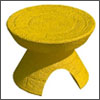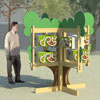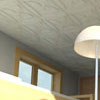The purpose of this project was to create a chair/table module, which could be produced in FABLAB (using their machines), in accordance with INDEX Brief 5 – Innovative Ideas for the Education Sector. We chose the “Open” option because it allowed us to address any of the areas of concern/ need; such as shortages in the areas of equipment and supplies and inadequate facilities – all within low income communities and emergency affected areas. In our case, we focused on the semi-rural township area of Shoshanguve.

As design students an understanding of the entire design process from start to finish is essential in order for us to learn the effects and importance of design within our day-to-day living. In our brief we were asked to fabricate a working toy propeller on the in house milling machine in the Fab Lab in Soshanguve, North Pretoria. Throughout this project we had to learn about the basic fabrication processes, and in turn come up with a Design Rationale for our toy propeller. In doing this we were expected to try and experiment with all types of materials and molding and casting processes as well as to learn how a milling machine works. Below is an example of the type of toy propeller we were gong to work from.

This projects aims to address the challenge put forward by the INDEX design brief: Designing for Education. INDEX has collaborated with UNICEF, Unite for Children Organization, to address the issues of inadequate and total absence of school structures, facilities and furniture. Both INDEX and UNICEF are non profit organizations, and the brief is based on the CHILD FRIENDLY SCHOOLS MODEL (CFS), designed by UNICEF: which aims to ensure that every child – regardless of gender, ethnicity, socioeconomic background or circumstances – has access to a quality education. They advocate for the protection of children’s rights, to help meet their basic needs and to expand their opportunities to reach their full potential.
We were required to design a press-fit 3 dimensional puzzle which almost anybody could recreate using the tools at a Fablab. The intention of this project, was to allow children within the Fablab community to make an educational yet fun puzzle, while learning to use a range of Fab tools in combination to make fun and innovative things. This required that ‘users’ of the lab have access to a physical prototype of the puzzle that we developed, as well as the “instructables” or instructions that are required to be followed to re-make the project.

Shoshanguve has an abundance of informal road-side traders. These traders are required to transport and store their goods daily. Students where asked to design a display system that would cater to the needs of such vendors.

Many of the houses situated in Shoshanguve lack appropriate thermal insulation and suffer from uncomfortable heat gain in summer and extreme heat loss in winter. In most cases, this is due to the fact that roofs are constructed from corrugated iron and there is no ceiling space. Students were asked to investigate possible solutions to this problem that could be developed in the Fab Lab.
Students where asked to develop a “Do-It-Yourself” toy construction project, which would enable the children of Shoshanguve to fabricate their own toys by using the tools made available by the Fab Lab to their best advantage.

